Colombia has been successful in flattening the coronavirus curve. A big question many people have is “When will the quarantine be lifted in Colombia?”. The nationwide Colombia quarantine was until September 1, what happens on September 1?
To answer this question, we first look at coronavirus cases in Colombia and the trend of new cases in Colombia and the three biggest cities: Bogotá, Medellín and Cali. Also, we look at the success Colombia is having in preventing the spread of coronavirus throughout the country.
In addition, we look at the increase of COVID-19 testing in Colombia and the impacts of the quarantine on the economy in Colombia. Finally, we look at what the Colombian government has said.
But we believe changes are very likely, as the harm to the Colombian economy is tremendous.
Colombia Quarantine Extended to September 1
Colombia’s initial nationwide quarantine was originally ending on April 13 but it has now been extended eight times:
- On April 6, was extended to April 26
- On April 20, was extended to May 11.
- A third time was extended to May 25
- A fourth time was extended to May 31
- A fifth time was extended to June 30
- On June 23, was extended a sixth time to July 15
- On July 7, was extended a seventh time to August 1
- On July 28, was extended an eighth time to September 1
So, the national quarantine is now for 160 days and officially ended on September 1.
The Colombian borders will continue to be closed except for the border with Ecuador opening on June 23 just for humanitarian transit of citizens and permanent foreign residents. Also, there will be no domestic flights during the period from June 1 to mid-July. Domestic flights in Colombia resumed with a pilot in July.
Also, according to the Minister of transport, international flights will be restricted until August 31 with international flights resuming in September with a pilot.
A new phase began from June 1 to 30 with the reactivation of museums, libraries and some other businesses. Also, starting in June, starts an “intelligent lockdown” that would allow the relaxation of restriction of movement measures based on regional conditions. These regional relaxation measures will be expanded “gradually” to recover productive life.
In addition, those over 70 will remain in isolation. But guidelines will be released so that those over 70 are allowed to have some time outside, with precautions and limitations.
A Flatter Coronavirus Trajectory Curve for Colombia
As a result of Colombia rapidly implementing preventive measures, Colombia is experiencing a flatter curve for coronavirus cases than several other countries, as seen in the following graphic (Colombia is the dark blue line at the bottom of the graphic):
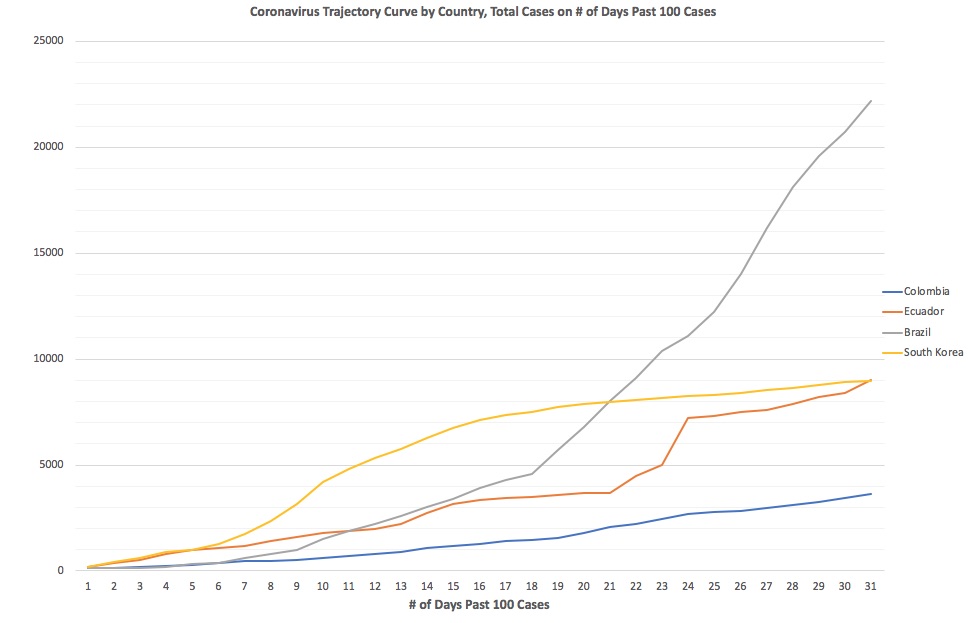
Coronavirus Trajectory Curve by Country, Total Number of cases on # of Days Past 100 Cases, data source John Hopkins University, 4/19
Coronavirus Cases in Colombia
Colombia Ministerio de Salud (Ministry of Health) reported the number of coronavirus cases in Colombia on November 2 – a total of 1,093,256 cases with 31,670 deaths.
The first coronavirus case in Colombia was on March 6, 2020 and by November 2 the number of cases had grown to 1,093,256 cases. The following chart shows a running 7-day average of new coronavirus cases in Colombia daily, so you can see the trend of new daily cases for more than the past month.

7-day running average of new daily coronavirus cases in Colombia, data source: Instituto Nacional de Salud, Nov. 2
The increase in daily cases is mainly due to an increase in cases in 27 cities in Colombia.
Red Cities in Colombia – Major Increase of Cases in Past 80 Days
In the 80 days from August 15 to November 2, a total of 71 percent of the coronavirus cases in Colombia were in the 27 cities of Apartadó, Armenia Barrancabermeja, Barranquilla, Bello, Bucaramanga, Bogotá, Cali, Cartagena, Cúcuta, Dosquebradas, Envigado, Ibagué, Itagüí, Manizales, Medellín, Monteria, Neiva, Pasto, Pereira, Santa Marta, Sabanalarga, Sincelejo, Soacha, Soledad, Valledupar and Villavicencio, with the 27 cities in Colombia averaging 6,032 cases per day.
The over 1,100 other municipalities in Colombia not including these 27 cities during the same 80 days averaged 2,504 cases per day.
The following chart demonstrates this. The 27 cities in red were responsive for the increase in cases in Colombia to a peak in August. The same cities were responsible for the drop in the number of cases in Colombia, as these cities have dropped since mid-August and then heading back up and then down again and up.

7-day running average of new daily coronavirus cases in Colombia, data source: Instituto Nacional de Salud, Nov. 2
Clearly this chart shows the increase in coronavirus cases in Colombia over these 80 days is primarily due to a substantial increase in cases in the 27 cities of Apartadó, Armenia Barrancabermeja, Barranquilla, Bello, Bucaramanga, Bogotá, Cali, Cartagena, Cúcuta, Dosquebradas, Envigado, Ibagué, Itagüí, Manizales, Medellín, Monteria, Neiva, Pasto, Pereira, Santa Marta, Sabanalarga, Sincelejo, Soacha, Soledad, Valledupar and Villavicencio and Zipaquirá.
The rest of Colombia (blue line) not including these 27 cities has a relatively flat curve of new cases.
Also, we have a separate article that looks at the cities in Colombia with a major increase in coronavirus cases in more detail.
We next look at at the coronavirus case trends in Bogotá, Cali and Medellín, the three largest cities in Colombia.
Coronavirus Cases in Bogotá
On November 2, Bogotá had 324,385 cases, which was 29.7 percent of the total cases in Colombia. The first case in Bogotá was on March 6, 2020. And the peak of new daily coronavirus cases in Bogotá was reached on August 6 with 6,068 cases.
The following chart shows a running 6-day average of daily coronavirus cases in Bogotá, so you can see the trend of new cases for more than the past month.
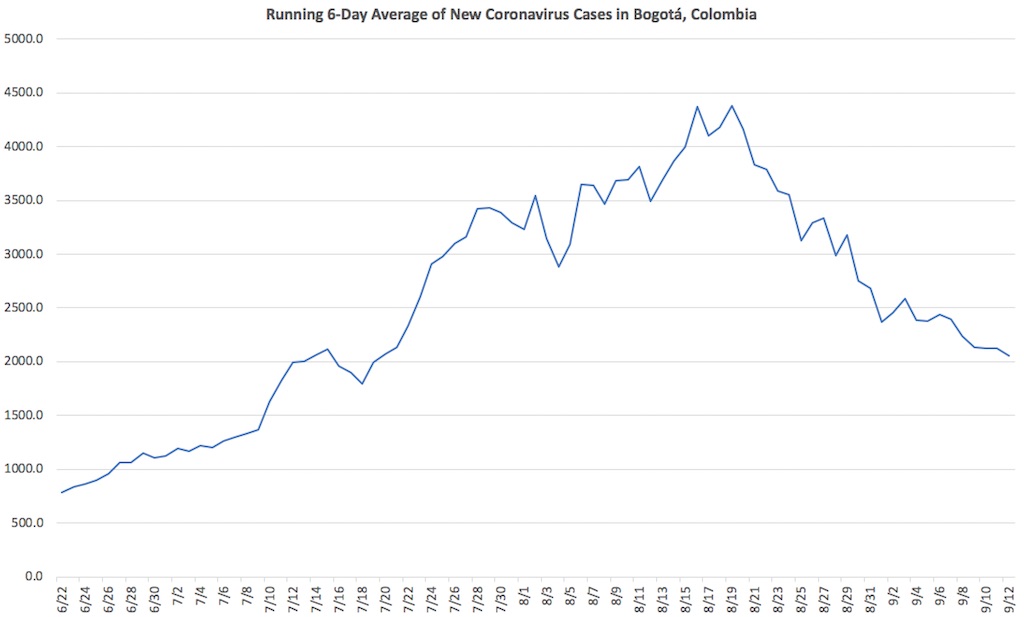
6-day rolling average of new daily coronavirus cases in Bogotá, data source: Instituto Nacional de Salud, 9/12
This rolling 6-day average chart for Bogotá shows that on average, the number of new cases started to drop in Bogotá after reaching a peak but then started to increase again heading to a new average peak, which impacted the overall Colombia curve.
Coronavirus Cases in Cali
On November 2, Cali had 63.489 cases, which was 5.8 percent of the total cases in Colombia. The first case in Cali was on March 15, 2020. And the peak of new daily coronavirus cases in Cali was reached on August 12 with 1,650 cases.
The following chart shows a running 6-day average of daily coronavirus cases in Cali, so you can see the trend of new cases for more than the past month.

6-day rolling average of new daily coronavirus cases in Cali, data source: Instituto Nacional de Salud, 7/24
This rolling 6-day average chart shows that on average, the number of new cases in Cali have been increasing at a fairly steady rate with some minor ups and downs.
Coronavirus Cases in Medellín
On November 2, Medellín had 99,977 cases, which was 9.1 percent of the total cases in Colombia. The first case in Medellín was on March 9, 2020. And the peak of new coronavirus cases in Medellín was reached on August 10 with 1,613 cases.
The following chart shows a running 6-day average of daily coronavirus cases in Medellín, so you can see the trend of new cases for more than the past month.

6-day rolling average of new daily coronavirus cases in Medellín, data source: Instituto Nacional de Salud, 7/24
This rolling 6-day average trend chart shows that on average, the number of cases per day in Medellín was fewer than 100 and started to increase in late June heading to a new peak.
COVID-19 Testing in Colombia
On March 14, 2021, Instituto Nacional de Salud (INS) in Colombia reported that it had completed a total of 11,989,901 COVID-19 tests in Colombia.
This means that Colombia has completed 235,260 COVID-19 tests per million people in Colombia based on a population of 50.96 million.
Colombia has been increasing testing for coronavirus but dropped for several weeks before increases again, as seen in the following graphic:

Counts of COVID-19 tests in Colombia by week, data source Instituto Nacional de Salud, Mar 15
For the week of March 6 to 14, 2021, Colombia averaged 38,670 tests per day. In addition, the most tests Colombia has completed in one day was on January 14, 2021 with 93,302 tests.
For the week of February 1 to 7, Colombia averaged 58,885 tests per day. This was up dramatically from the week of August 3-16, when Colombia averaged 39,237 tests per day.
We have a separate article that looks at COVID-19 testing in Colombia in more detail.
Coronavirus Cases in Colombia are NOT Nationwide
On November 2, 2020, the majority of coronavirus cases – 851,174 – (77.9 percent) of the cases in Colombia were in only 10 departments (states) in Colombia out of 33 departments (including the district capital of Bogotá):
- Bogotá DC – 324,385 cases
- Antioquia – 173,219 cases
- Valle del Cauca – 85,073 cases
- Atlántico – 72,288 cases
- Santander – 43,222 cases
- Cundinamarca – 43,093 cases
- Bolivar – 33,424 cases
- Córdoba – 26,536 cases
- Cesar – 26,293 cases
- Huila – 23,641 cases
Coronavirus Cases by City in Colombia
Also, in terms of cities in Colombia on November 2, 2020, the majority of coronavirus cases – 748,502 cases – (68.5 percent) were in only 18 cities in Colombia:
- Bogotá – 324,385 cases
- Medellín – 99,977 cases
- Cali – 63,489 cases
- Barranquilla – 41,276 cases
- Cartagena – 26,664 cases
- Bucaramanga – 18,326 cases
- Villavicencio – 17,480 cases
- Valledupar – 17,434 cases
- Monteria – 15,648 cases
- Neiva – 15,472 cases
- Bello – 15,376 cases
- Ibagué – 15,277 cases
- Soledad – 14,962 cases
- Cúcuta – 14,214 cases
- Soacha – 12,714 cases
- Pasto – 12,200 cases
- Pereira – 12,035 cases
- Santa Marta – 11,573 cases
On November 2, Medellin Guru reviewed a list of 1,099 municipalities in Colombia and found over 30 that did not have a single coronavirus case.
In addition, on November 2, over 90 of the cities and towns in Colombia with at least one reported coronavirus case haven’t experienced a new case in over two weeks
The Quarantine Impacts on the Colombian Economy
At the beginning of 2020, Banco de la República in Colombia projected that the Colombian economy would grow 3.7 percent in 2020.
Today the situation is completely different, due to the coronavirus pandemic and a national quarantine shutting down much of Colombia’s economy.
According to Finance Minister Alberto Carrasquilla, the Colombian economy is expected to contract by 1.5 to 2 percent in 2020, influenced by the effect of the April-June quarter that would be “the worst in Colombia’s economic history”.
But a 1.5 to 2 percent contraction is highly questionable unless Colombia lifts the quarantine quickly and the economy recovers rapidly. If the nationwide quarantine continues for much longer, the harm to Colombia’s economy will be immense.
The Fedesarrollo think tank updated its growth projections for Colombia and for a scenario with a weak recovery in private consumption for the remainder of the year, this would lead to a fall in GDP of 7.9 percent in 2020 and unemployment hitting 20.5 percent.
The most optimistic outlook from Fedesarrollo implies a contraction of the economy of 2.7 percent for this year and an unemployment rate at the end of 2020 of 16.3 percent. According to Fedesarrollo, the hardest hit sectors of the economy include trade, transportation, tourism, food services, entertainment and construction.
In addition, according to Departamento Administrativo Nacional de Estadística (DANE) micro, small and medium-sized companies represent 80 percent of Colombia’s employment. The small and medium business are experiencing huge issues with working capital, unable to pay employees and many have already shut down.
The risk of continuing the quarantine much longer is that many small businesses in Colombia will likely fail and unemployment could skyrocket in Colombia.
What Has the Government Said – When Will the Quarantine be Lifted in Colombia?
On April 16, Colombia’s health minister indicated that the government plans to lift quarantine measures for “certain sectors of the economy” while maintaining a general lockdown.
In a virtual session with Congress, Health Minister Fernando Ruiz confirmed President Ivan Duque’s plan to “recover productive life without social life” in Colombia starting on April 27 when the current nationwide Colombia quarantine ends:
The strategy will be to maintain obligatory preventative lockdown for specific groups and maintain the obligatory preventive lockdown for the entire population with the option of a very systematic, very gradual and very controlled global opening of some sectors of the economy.
Editors note, there is a nationwide quarantine in Colombia that began on March 24. Colombia’s initial nationwide quarantine was originally ending on April 13 but it has been extended eight times to September 1:
- On April 6, was extended to April 26
- On April 20, was extended to May 11.
- A third time was extended to May 25
- A fourth time was extended to May 31
- A fifth time was extended to June 30
- On June 23, was extended a sixth time to July 15
- On July 7, was extended a seventh time to August 1
- On July 28, was extended an eighth time to September 1
So, the national quarantine is now for 160 days but the quarantine ended on September 1.
However, the quarantine extension from April 27 until May 11 started to lift the quarantine. President Duque announced that the mandatory quarantine, will allow, with very strict protocols, to open the manufacturing and construction sectors of the economy in Colombia.
Other sectors of the economy including textiles, clothing and leather; chemical substances; wood, paper and cardboard; metals and electronic equipment were also permitted to return to work on April 27.
Also, starting on May 11, several additional sectors were be permitted to return to work:
- Manufacture of furniture, mattresses and bed bases.
- Manufacture of motor vehicles, trailers and semi-trailers.
- Manufacture of computer, electronic and optical products.
- Manufacture of machinery and equipment.
- Maintenance and repair of motor vehicles.
- Maintenance and repair of technology and computer equipment.
- Wholesale and retail trade of vehicles (including parts, pieces and accessories).
- Wholesale trade of furniture and household goods.
- Wholesale trade of machinery and equipment.
- Retail trade of pet products.
- Retail trade of construction materials, hardware, locksmiths and glass and paint products in specialized stores.
- Retail trade of fuels, lubricants, additives and cleaning products for motor vehicles in specialized establishments.
- Retail trade of books, newspapers, materials, stationery and desks in specialized stores.
- Laundry services at home.
- Activities related to the operation of establishments providing vehicle maintenance services, appliances, boats, agricultural or fishing machinery, according to the different modes of transport, as well as the establishments in which the supply and / or installation of vehicles spare parts.
- Automotive diagnostic centers.
During the quarantine extension to May 31, events will not take place and bars and discos will remain closed, restaurants can only provide domicilio (delivery) and universities and other schools will remain closed.
Also, Duque reiterated that domestic and international flights will not be opened in Colombia until the end of June.
In terms of municipalities in which coronavirus infections have not yet been confirmed with coronavirus cases, President Duque on April 20 said:
In hundreds of municipalities in Colombia, there have been no cases of COVID-19, so there we are going to promote a productive economic recovery but maintaining all the protocols for the protection of health and life.
So, according to President Duque, it appears that Colombia will be starting to lift the quarantine even more in cities and towns and departments (states) without a coronavirus presence.
COVID-19 Free Municipalities Can Open on May 11
In the municipalities without affectation of COVID-19, all the economic opening will be allowed starting on May 11, with some exceptions: billiards, casinos and discotheques, churches, parks, gyms and sporting events.
This measure will only apply if the mayor expressly requests the Ministry of the Interior to reopen the sectors or activities that he deems pertinent and prior certification from the Instituto Nacional de Salud (INS) in this regard.
To guarantee that the municipalities remain uncontaminated, the local authorities must implement biosecurity measures at their borders.
Once the existence of a case of contagion in a municipality by the INS is certified, the opening of economic sectors carried out should be automatically restricted and the quarantine reestablished in general for the affected municipality. So, municipalities that open up need to remain virus free.
Starting on May 18, Colombia started to lift the quarantine in 90 COVID-19 free municipalities, so they can start to return to normal. And over 100 municipalities in Antioquia were also permitted to start to lift the quarantine. But most of these municipalities experienced cases and were returned to quarantine.
Medellin Guru’s Coronavirus Series
Medellin Guru has a series of articles about the coronavirus pandemic and the impacts in Colombia: Also, these articles are being kept up-to-date, as this is a fast-moving topic:
- 8 Reasons Why Colombia is Unlikely to Return to a Quarantine
- Coronavirus Cases Increase in Medellín: What Happens Next?
- New Normal in Medellín: Medellín is Returning to Normal
- Will the Quarantine Return to Colombia? What if Cases Increase?
- New Normal in Medellín: Medellín is Returning to Normal
- Colombia’s Quarantine Ends on September 1: New Phase Starts
- Tourism Impact of Coronavirus: Colombia Starts to Reactivate Tourism
- Economy Impacts in Colombia Due to Extended Quarantine
- Epicenter of Coronavirus in Colombia: Bogotá is the Epicenter
- Medellín Plans the Total Reopening of Economic Activities in the City
- When Will the Quarantine End in Colombia? On September 1?
- Humanitarian Flights from Colombia to the U.S. and Other Countries
- Beware of Fake News in Colombia About Coronavirus and Quarantines
- Reopening Gymnasiums, Churches and Movie Theaters in Colombia
- Reopening Amusement Parks, Zoos and Nature Reserves in Colombia
- Medellín Starts Free COVID-19 Tests on the Medellín Metro
- New COVID-19 Preventive Measures in Medellín to Contain the Pandemic
- Penalties for Violating the Quarantine in Medellín are Stiff
- COVID-19 Orange Alert in Bogotá: New Lockdowns in Bogotá
- Medellín Starts to Lift the Quarantine: Enters Smart Isolation Phase
- Colombia Started to Lift the Quarantine – What Does this Mean?
- Coronavirus: When Will the Quarantine Be Lifted in Colombia?
- Colombia Starts to Lift the Quarantine in COVID-19 Free Areas
- Colombia Quarantine: Nationwide Quarantine Extended to September 1
- Coronavirus in Colombia: Myth vs Reality – Current Status
- Coronavirus Hospitalization in Colombia: Myth vs Reality
- Are Medellín and Antioquia Winning the Coronavirus Battle?
- 23 Cities with a Major Increase in Coronavirus Cases in Colombia
- Colombia Coronavirus Death Rate: What are the Chances of Dying?
- Coronavirus: When Will Things Return to Normal in Colombia?
- COVID-19 Testing in Colombia: Realty About Coronavirus Testing
- Life as an Expat: During Medellín’s Coronavirus Quarantine
- Colombian Visa Process Changes: Due to Quarantine and Coronavirus
- Medellín Coronavirus Closures – What is Closed in Medellín?
- Pico y Cedula: A Restriction for Grocery Shopping in the Aburrá Valley During the Quarantine
- Pico y Cedula in Colombia: Which is Strictest Out of 5 Largest Cities?
- Medellín Quarantine Starts on March 20 for Four Days
The Bottom Line: Coronavirus – When Will the Quarantine Be Lifted in Colombia?
The bottom line is the measures that Colombia has put in place in response to the coronavirus pandemic have resulted in a flatter curve and new coronavirus cases are starting to drop in Colombia. Also, Colombia appears to have been successful in preventing the spread of coronavirus throughout Colombia.
The challenge facing Colombia is now how to open things back up without increasing the rate of infections.
Watch carefully the number of new cases reported in Colombia daily. Each day we update our popular article about coronavirus in Colombia with the current coronavirus statistics. If a downward trend continues, it becomes more likely that lockdowns will continue to be relaxed.
When will the quarantine be lifted in Colombia? When this article was first published on April 17, we expected to see some partial lifting on April 27 with some sectors of the economy slowly opened up. And the quarantine in Colombia ended on September 1.
And we were correct, as on April 27, several sectors of the economy including manufacturing and construction were permitted to return to work. This is a total of up to 6 million Colombians permitted to return to work. And additional sectors of the economy were permitted to return to work starting slowly on May 11.
Also, we hoped when this article was published on April 17, that Colombia should consider that over one-third of the population in Colombia lives in municipalities that don’t have any coronavirus cases reported or haven’t reported a new case in over two weeks.
These municipalities without any cases don’t need the more stringent restrictions that are put in place in Bogotá, which has the highest rate of coronavirus cases in Colombia. And Colombia started lifting restrictions in municipalities without any cases.
Also, watch the COVID-19 testing numbers in Colombia. We update our popular article about COVID-19 testing in Colombia daily. If COVID-19 testing numbers continue to increase, this is a very good thing, as this will help identify more of those who are infected in Colombia.
Ideally, testing could be used to check not only everyone who has symptoms but also their close contacts, so they could be identified as infected, isolated or quarantined as well.
Furthermore, we don’t expect that international travel to Colombia will be permitted any time soon, considering the much higher coronavirus infection rates in many other countries in the world. International flights will not be opened until at least until in September.
Sign up for the Free Medellin Guru Newsletter – You can see all of the previous Medellin Guru weekly email newsletters and sign up here.
Editors note: updated on July 28, 2020 with information that the quarantine in Colombia has been extended to September 1.
Editors note: updated on August 12, 2020 with coronavirus case counts for August 11.
Editors note: updated on August 14, 2020 with coronavirus case counts for August 13.
Editors note: updated on August 21, 2020 with coronavirus case counts for August 20.
Editors note: updated on August 26, 2020 with coronavirus case counts for August 25.
Editors note: updated on August 29, 2020 with coronavirus case counts for August 28.
Editors note: updated on September 5, 2020 with coronavirus case counts for September 4.
Editors note: updated on September 11, 2020 with coronavirus case counts for September 10.
Editors note: updated on September 19, 2020 with coronavirus case counts for September 18.
Editors note: updated on September 25, 2020 with coronavirus case counts for September 24.
Editors note: updated on October 4, 2020 with coronavirus case counts for October 3.
Editors note: updated on October 12, 2020 with coronavirus case counts for October 11.
Editors note: updated on October 20, 2020 with coronavirus case counts for October 19.
Editors note: updated on October 27, 2020 with coronavirus case counts for October 26.
Editors note: updated on November 2, 2020 with coronavirus case counts for November 2.


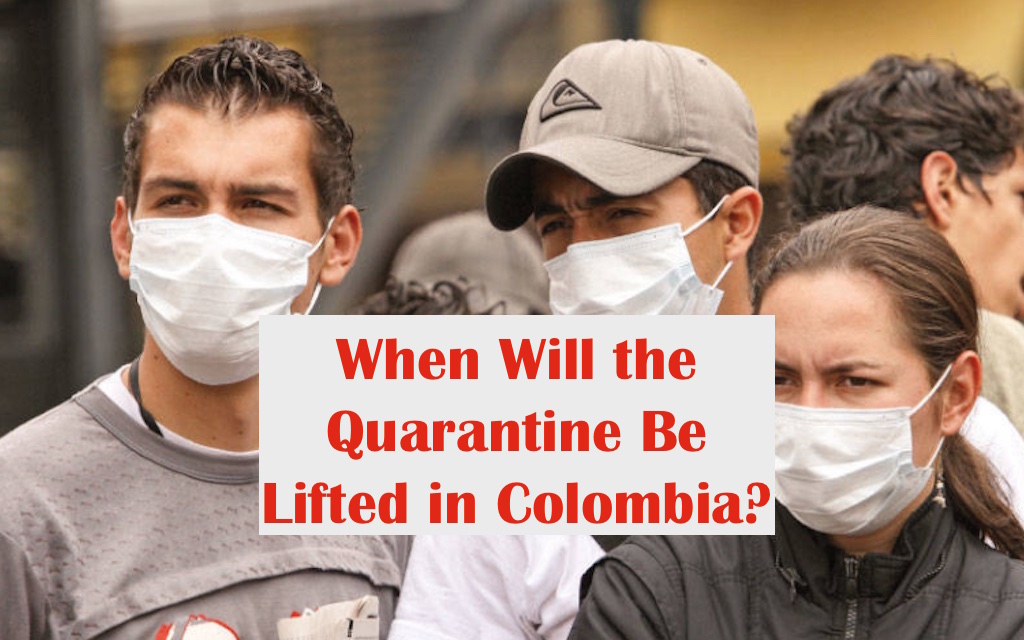
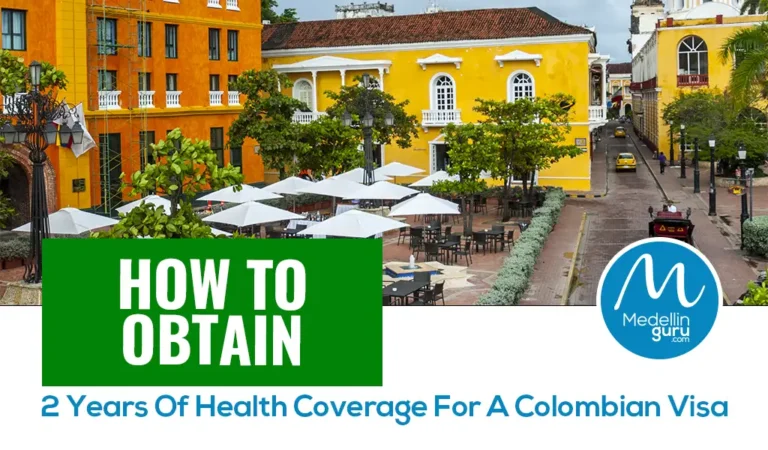




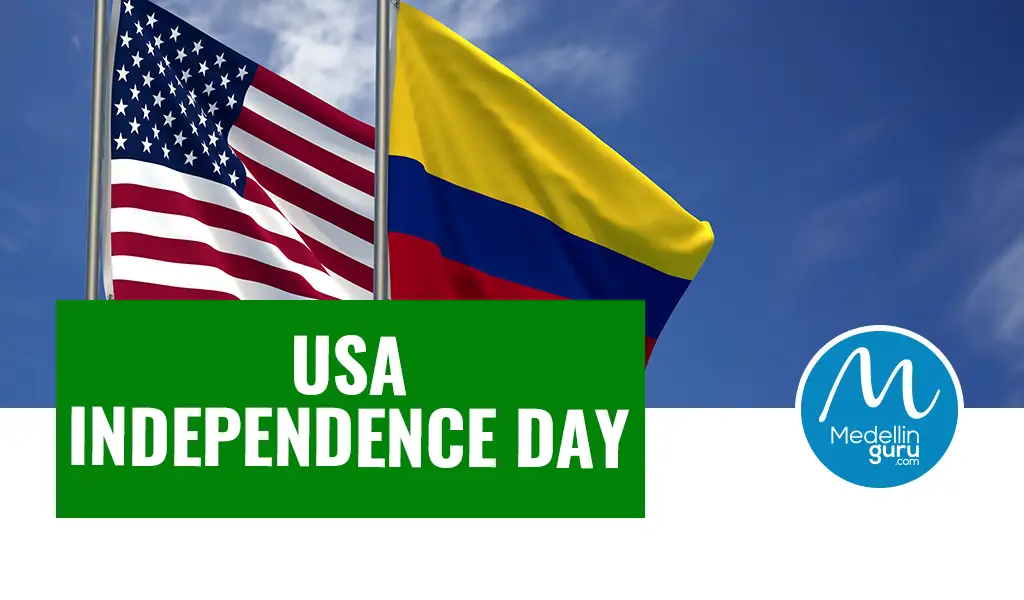
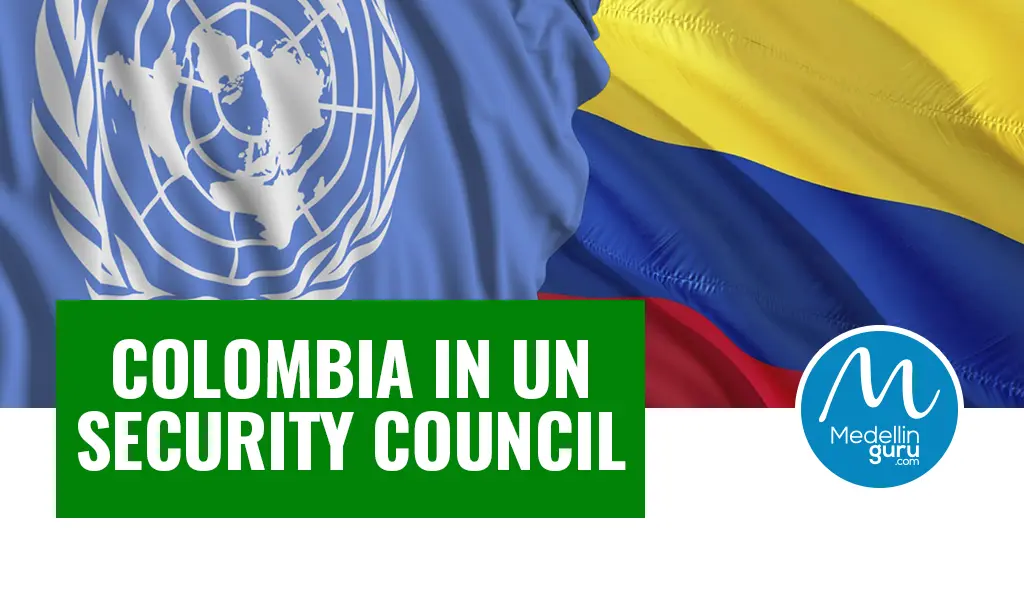
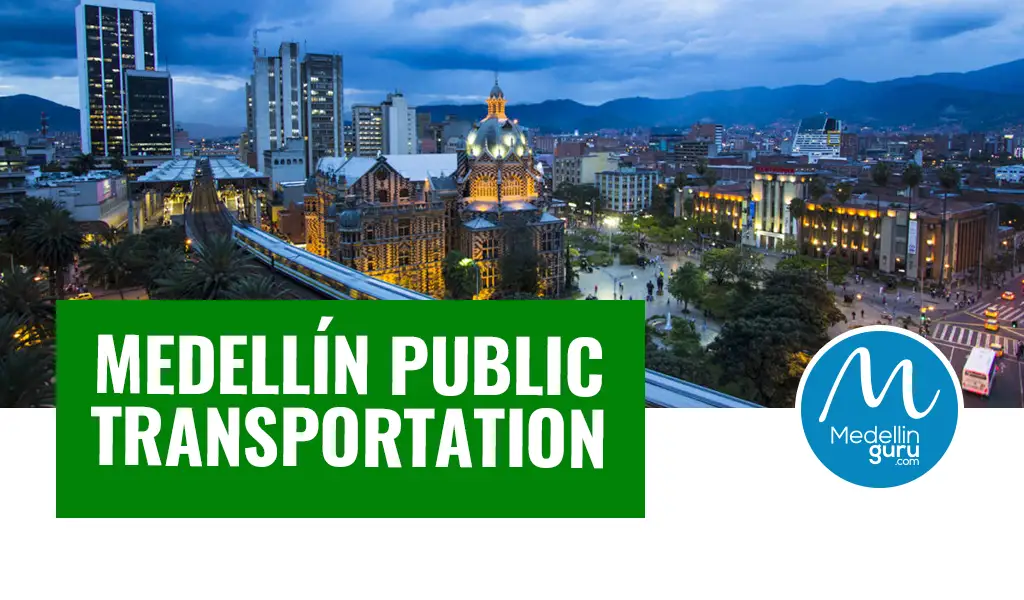
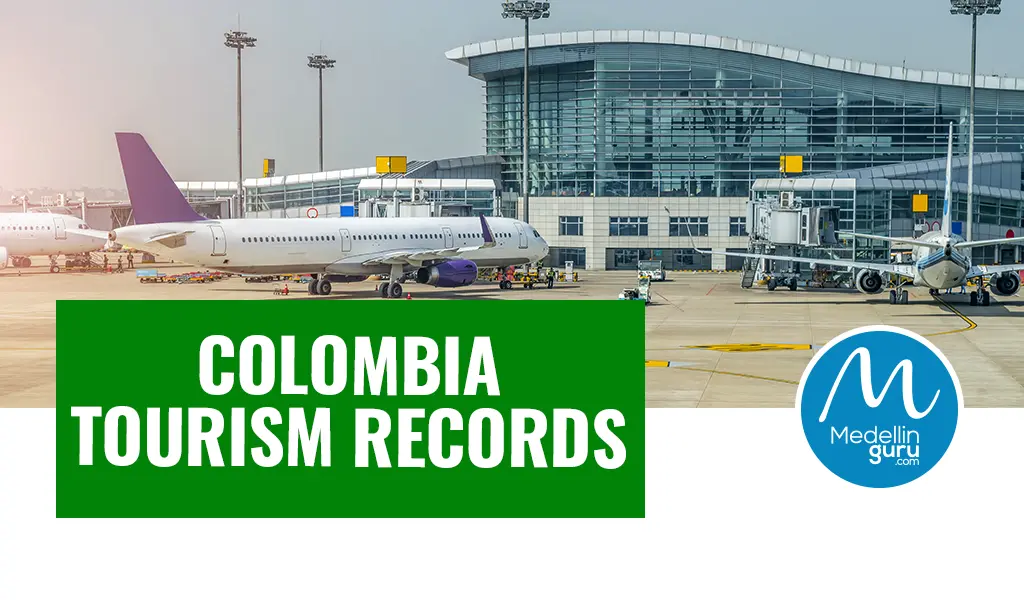
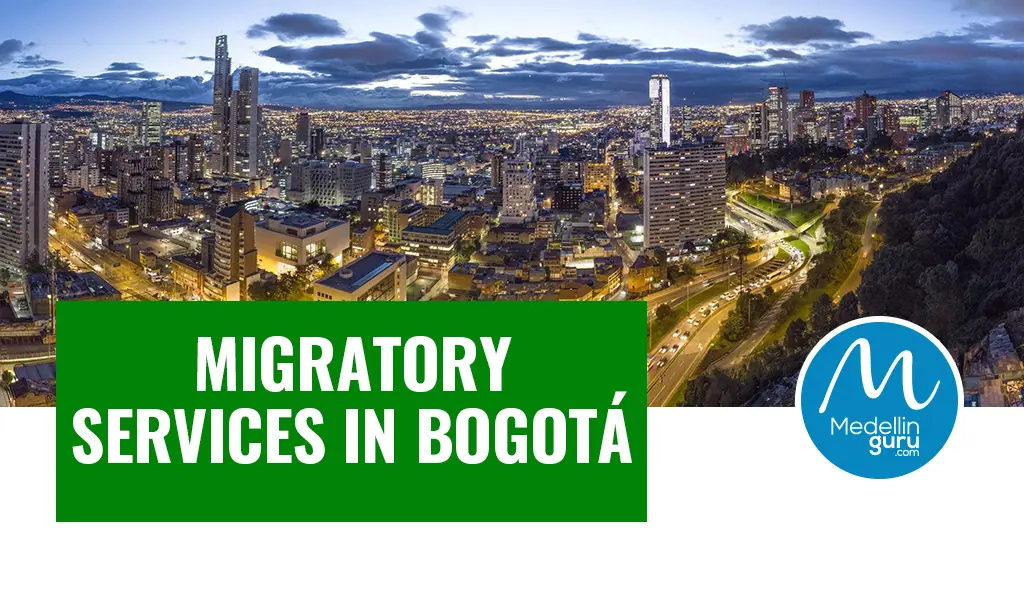
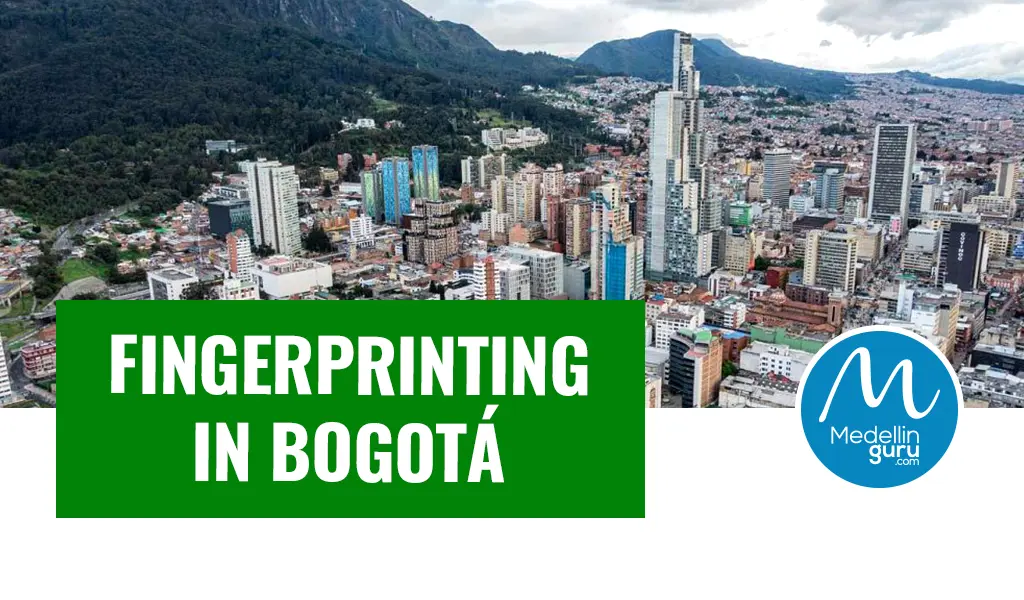




















22 thoughts on “Coronavirus: When Will the Quarantine Be Lifted in Colombia?”
Nice article, thanks for keeping it up to date with current information and I like the rolling average graphs.
Hi, I visit Medellin regularly and I am in love with the city. I started a gofundme project to provide food/support to orphanges and food banks in Medellin. It would be very helpful if you or the community at large has any photos or stories on the effect of the pandemic in Medellin.
Jeff has Colombia actually flattened the curve, given reports test have gone unprocessed due to lack of reactive or certain Health organization collecting samples but then refuse to send them to be tested…. if such is true than the Colombian Government and people are moving forward blind to the crisis
Yes, Colombia has flattened the curve. Before the quarantine from March 14 to March 24, Colombia was experiencing a daily increase in cases of 34.5 percent per day. In the past 17 days during the quarantine until yesterday, the daily increase in cases has dropped to an average increase of 11.1 percent per day over this 17 day period. This is flattening the curve over a period of over a month.
Colombia has more done testing per million in population than Brazil, Mexico or Argentina and is increasing testing – https://medellinguru.com/covid-19-testing/. This is a major thing to watch over the few weeks. Will the case count increase as testing increases in Colombia? And at what rate, will the daily percentage change increase or drop from an average of 11 percent.
Brazil is in denial there is a pandemic, Mexico was slow to respond, and I don’t think Argentina did much at the beginning. According to Worldometer Venezuela has done 9 times the testing , Peru over 3.5 times more testing , Spain over 17 times and South Korea over 9 times the testing ( they are similar size population as Colombia) ( this is as of today) There is no question the number being tested in Colombia has increased in the last 2 weeks . increased testing tends to drop the percent per day testing positive . the number one wants to look at is the number of new cases each. I doubt very much Colombia has peaked yet not even the US has peaked . My own home State is days away from peaking . I understand the need to reopen things in Colombia as people are suffering in this lock down from hungrier, domestic violence increases, but the last thing Colombia needs is a second wave of infections which if one looks at South Korea and history is not good…
You are comparing apples and oranges, you can’t compare Colombia testing to Spain and South Korea as these two countries started testing much earlier due to their first cases being much earlier than in Colombia. South Korea’s first case was on January 10 and in Spain it was on January 31. In Colombia, the first case was on March 6. It is more fair to compare Colombia to other countries in Latin America, which had first cases around the same time. Asia and Europe started testing much earlier so have been doing testing much longer.
Comparing apples and oranges also with Venezuela also. Venezuela is using a rapid blood antibody test from China, not the same RT-PCR test in Colombia done in a lab. Colombia does not report rapid test numbers, only reports PT_PCR tests done in a lab. See: https://apnews.com/1fbe6e7f1c6d0fa927e899994cd88784. Venezuela’s testing numbers are a joke.
We look at the new cases in Colombia daily. In the charts above, Colombia hit a peak 11 days ago and new cases have been lower since. But this may change as Colombia does more tests and Colombia starts to lift the quarantine. Colombia has a relatively low positive percentage for tests, only 6.1 percent, and this should drop as more tests are done – https://medellinguru.com/covid-19-testing/
from march 9th Colombia went to testing roughly 288 per day to March 29th testing roughly 1271 a day( ave 728 a day) you say the rate of positives was 34.5% the week of April 6th Colombia was testing 2186 a day roughly 3 times as many with a positive rate of 11.1% . You have increased the number of tested by 3 times so yes because you have a larger sample the infection rate number should drop as you have a larger sample but 11.1 x 3 times increase in sample size gives you 33.3% thus the actual drop is only 1.2% from March 9th . Colombia’s infection has barley dropped from over a month ago.. ( 100 apples with 34.5% rotten = 34.5 rotten apples, 300 apples with 11.1% rotten =33.3 rotten apples )
I NEVER said the rate of positives was 34.5% the week of April 6. I said the average daily rate of growth of cases NOT rate of positives. “Before the quarantine from March 14 to March 24, Colombia was experiencing a daily increase in cases of 34.5 percent per day.”
The only rate of positives we have published is the total for Colombia, which is 3,621 positives/59,002 cases = 6.1 percent in the table in this article. https://medellinguru.com/covid-19-testing/
I looked at the data we have from INS and the rate of positives from April 1 to April 10 was 8.2 percent. And the rate of positives in the past four days with increased testing was 4.7 percent. So, the rate of positives is dropping as they do more testing.
I’m not convinced that comparing the number of positives to the number of tests over time is a valid way of assessing flattening. Surely, the percentage growth in the total number of cases is a more valid measurement. What we don’t know about testing is what proportion of those tested were showing symptoms. For example, if in the early days only people with symptoms were being tested (although I know from personal experience that was not the case) but now more of the general population are being tested, the results would be totally distorted. Flattening or otherwise is better determined from a graph of the total number of cases reported (not just new cases) over time. It should be easy to see if the graph is flattening. I would also like to see a similar graph comparing the number of deaths to the number of reported cases over time. Is that a constant rate?
Sorry the government doesn’t report the proportion of those tested that were showing symptoms. No government that I am aware of does that.
We have an early total number of cases trajectory graph, see the graph “Coronavirus Early Trajectory Curve by Country, Number of cases on # of Days Past 100 Cases” in this article – https://medellinguru.com/coronavirus-in-colombia/ comparing to other countries. So Colombia had a flatter growth initially.
If extend that graph, the other countries I believe will be rocket ships and Colombia will remain pretty low, with a much flatter growth. I may update that graph but will take time.
I updated and added a total number of cases trajectory graph to this article that has data up to yesterday that compares Colombia with Ecuador, Brazil and South Korea. I had to remove the U.S. as the U.S. was over 250,000 cases by day 31 in this graph. This graph demonstrates that Colombia has a “flatter curve”.
Any word if international flights out of Colombia will resume at the beginning of May?
Very unlikely, borders will remain closed and domestic flights will continue to be banned “until an evaluation is made when the emergency ends”.
Do you think we will be able to go to places like Guatape or Santa Fe? Or will that be considered “domestic travel”?
During the current quarantine, travel isn’t a permitted activity and the buses terminals are closed.
We will see what happens after April 26. But I suspect that places that don’t have coronavirus cases won’t want visitors. Both Guatapé and Santa Fe Antioquia each have a single case. Also, I have seen in the news that that Santa Fe closed its roads to travelers.
Hi Jeff,
Thanks as always for being the pre-eminent source when it comes to Medellin info.
I feel we need to be very careful about informing people Colombia has ‘flattened the curve’ and assuming we have already reached peak infection. This simply is not the case by a long shot. Firstly, timescales you show above are not long enough to sufficiently analyze this. For instance, today we had over 200 cases confirmed nationwide as well- an increase again. A drop over 3-4 days doesn’t tell us enough, especially in light of the below.
Most importantly, the testing index tells us Colombia is among THE worst performing countries in the whole world for Coronavirus tests per 1m inhabitants. This means that we can rely little on this information at present. There simply is nowhere near enough testing happening to provide a clear picture. The level of testing is just inadequate to draw conclusions. Colombia is nowhere near reaching the WHO’s recommended pre-conditions for easing quarantine, of which rigorous testing are a key component.
I would urge you to reference the words of Colombia’s medical professionals, and even the health minister last night, who stated that total cases are probably at least 4x the ‘confirmed cases’ (and probably much more.) And also the mayor today, who cautioned that the worst is yet to come and millions of Medellin residents still stand to potentially get infected. We also know that thousands are on the streets in violation of quarantine every day (as he alluded) and there is looting happening.
We are nowhere near peak infection yet, unfortunately. However Colombia has an impossible balance to achieve with millions of already hungry people and an economy that had already bottomed out, so we may see quarantine relaxed out of economic necessity. Hard times await.
Colombia has flattened the curve over a period of over a month – this was not over 3-4 days. Before the quarantine from March 14 to March 24, Colombia was experiencing a daily increase in cases of 34.5 percent per day. In the past 17 days during the quarantine until yesterday, the daily increase in cases has dropped to an average increase of 11.1 percent per day over the past 17 day period. This is flattening the curve over a period of over a month.
Colombia has more done testing per million in population than Brazil, Mexico or Argentina and Colombia is increasing testing – https://medellinguru.com/covid-19-testing/. This is a major thing to watch over the few weeks. Will the case count increase as testing increases in Colombia? And at what rate, will the daily percentage change increase or drop from an average of 11 percent.
Be glad you all are in MDE as the situation socially is getting really ugly here in US. As soon as I can fly to Colombia I am on my way. Muy odioso acá!!
Hi Jeff
Typo in second paragraph. I think May should be March.
Thanks for catching that, fixed!
Aljazeera published that Colombia wont have international flights until May 30. Is that confirmed?
I wouldn’t count on it. Dates and predictions and promises are a comfort, but as we have seen, nothing is written in stone until you see airports open for business and airlines beginning to accept reservations, and then we are seeing airlines refusing
to issue refunds on previously cancelled flights. We are all stuck in limbo. We cannot even get a bus to leave town at this point, let alone boarding an airplane. This is all becoming a surreal experience unlike anything any of us have experienced in our lifetimes. All we can do is wait and see and stay safe by obeying the decrees. They are meant to protect us. Especially those of us retired expats over 70 we are the most vulnerable. Order in a nice meal and tune into some rerun football games you might have missed. We will get through this together. Our president Duque has been doing daily televised oval shaped table briefings with his team. They seem to be on top of things as best as they can and appear very well informed, calm and doing a good job enjoying high approval ratings on their handling of the situation. I for one trust their intentions and actions and normally I am highly skeptical of government. Let’s hope we will soon be able to at least travel safely out of here if we choose. Stay safe and remain cool headed.